Extract of plant Dendrobii caulis and preparing process thereof
a technology of extract and dendrobii caulis, which is applied in the field of preparing an extract from a plant, can solve the problems of degeneration of photoreceptors, degeneration of rpe, and obvious reduction of digestion ability of rpe,
- Summary
- Abstract
- Description
- Claims
- Application Information
AI Technical Summary
Benefits of technology
Problems solved by technology
Method used
Image
Examples
example i
Culturing of the Retinal Pigment Epithelium.
[0118]The fresh bovine eyes are collected from a slaughterhouse within 2–3 hr after slaughtering. The surfaces of the bovine eyes are sterilized with the tincture of iodine, and then are washed with the PBS (phosphate-buffer saline) buffer solution twice. After dissecting the bovine eyes and removing the lens, the vitreous body, and the retina in sequence, the dissected eyes are treated with 0.01% EDTA (ethylene diamine tetra-acetic acid) for 40 min and then 5% trypsin for 15 min. Then, a single RPE can be obtained after slightly pressing the eyes with a tweezers with round tips and pipetting several times. The pipetted solution is placed within the DMEM (Dulbecco's Modified Eagle Media) containing 10% FCS (fetal calf serum), and then is incubated in an incubator with a humidified atmosphere with 5% CO2 at 37° C. The medium is replaced per 5–6 days till the cells reach the confluency. The cells are subcultured with a medium containing 0.05...
example ii
Preparation of the Rod Outer Segments (ROS).
[0119]Fresh bovine eyes are kept on ice and exposed under a light for 30 min after obtaining from the slaughterhouse. The surfaces of the bovine eyes are sterilized with the tincture of iodine, and then are washed with the Hank's buffer solution twice. After dissecting the bovine eyes and removing the lens, and the vitreous body in sequence, the retina are taken out and cut into pieces and then treated with 20 mM Tris-HCl containing 20% sucrose. After stirred for 3 hrs at 4° C., the cell solution is filtered with filters of pore size of 300, 220, 110, 74, 53, and 10 mesh respectively. After counting the cell numbers, the cells are aliquoted with a number of 1×108 ROS cells per column, and the columns are stored in a refrigerator at −20° C.
example iii
Preparation of the FITC (Fluorescein Isothiocyanate)-ROS.
[0120]After the stored ROS cell solution is unfrozen and the suspension is removed, the unfrozen cell solution is mixed with 700 μl Borate buffer (pH 8.0) containing 10% sucrose and some FITC powder with a 1 / 1000 weight of the ROS is added. Then, the cell solution is stirred for 1.5 hrs at 4° C. The uncombined FITC without attached on the ROS is removed by washing with 20 mM Trans-acetate (pH 7.2) containing 20% sucrose. The cell solution is then centrifuged for 10 min at 10000 rpm. The relevant steps described above are repeated several times. Finally, the pellet is dissolved in the DMEM containing 2.5% sucrose.
PUM
| Property | Measurement | Unit |
|---|---|---|
| pH | aaaaa | aaaaa |
| pH | aaaaa | aaaaa |
| temperature | aaaaa | aaaaa |
Abstract
Description
Claims
Application Information
 Login to View More
Login to View More - R&D
- Intellectual Property
- Life Sciences
- Materials
- Tech Scout
- Unparalleled Data Quality
- Higher Quality Content
- 60% Fewer Hallucinations
Browse by: Latest US Patents, China's latest patents, Technical Efficacy Thesaurus, Application Domain, Technology Topic, Popular Technical Reports.
© 2025 PatSnap. All rights reserved.Legal|Privacy policy|Modern Slavery Act Transparency Statement|Sitemap|About US| Contact US: help@patsnap.com



